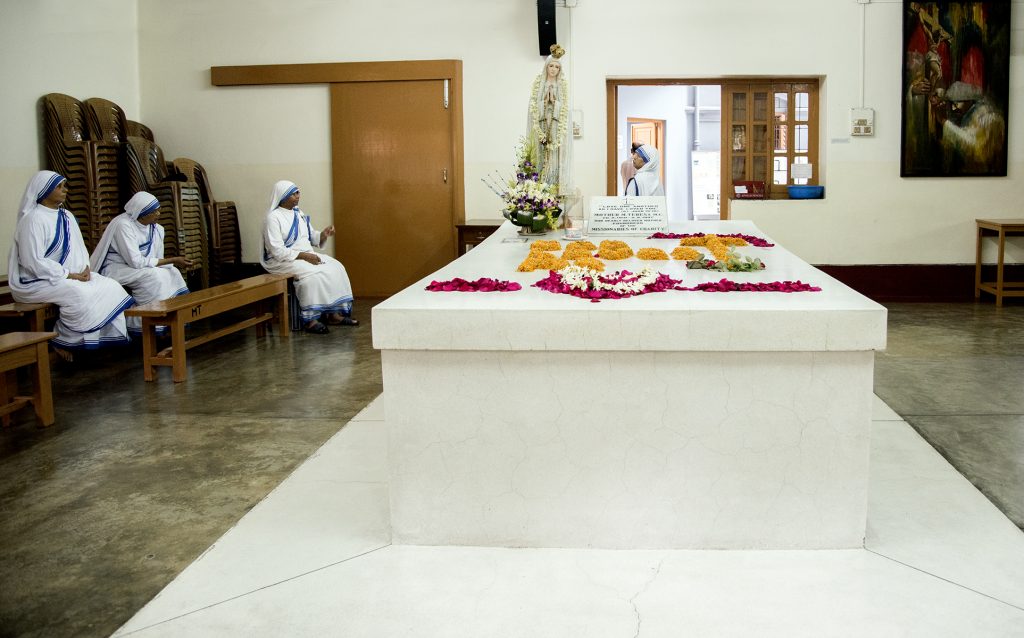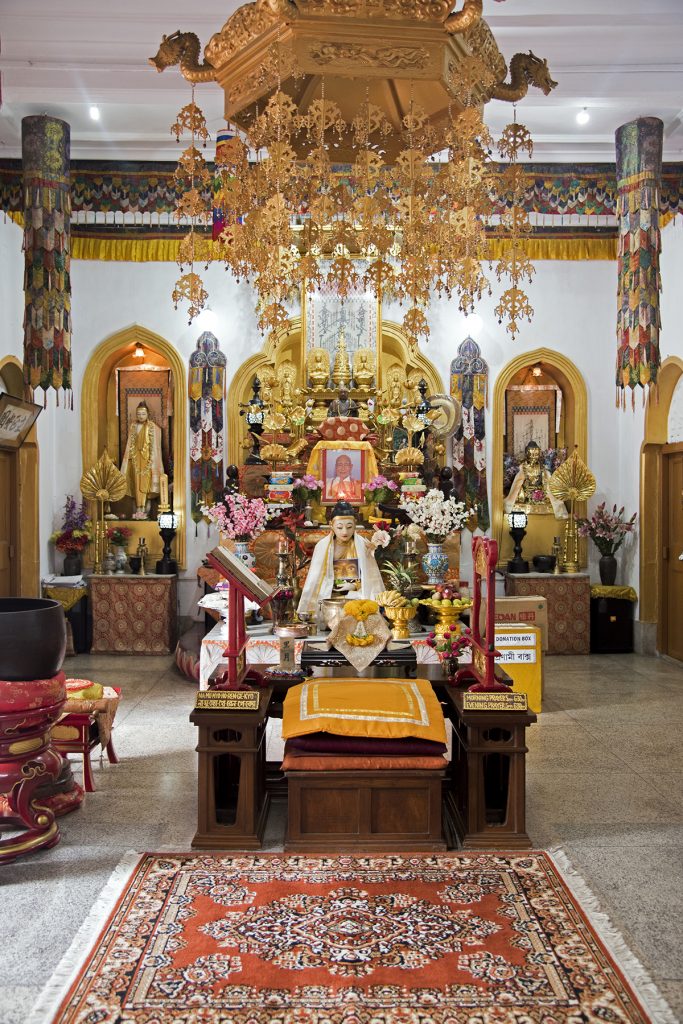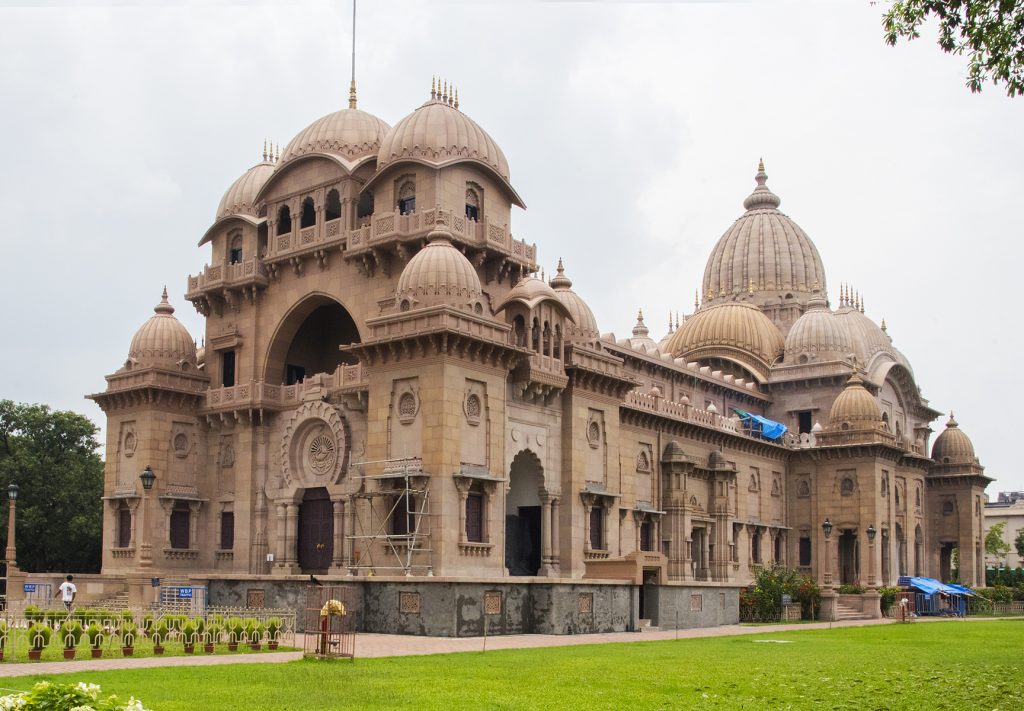by Jael Silliman

Kolkata is known for its numerous impressive colonial structures and the “palaces” and mansions of the zamindars (landowners), situated primarily in the north of the city. Citizens concerned about heritage are emphasizing the importance of valuing and preserving urban buildings of the nineteenth and twentieth century, built by the Bengali middle class, that melded architectural styles and influences. Interestingly, the many significant religious places that draw on global and pan-Indian architectural styles, have been largely overlooked in the discourses on Kolkata’s heritage.
In 2015, well-known photographer Mala Mukerjee sought to document this rich archive and approached me to collaborate with her. As one who has written extensively about the Jewish presence in the city and on the role of Kolkata’s diverse communities at a time when the contribution of minority communities across India are being undermined, I was interested in the project. Photographs speak universally, and I was confident that Mala’s compelling, uncluttered panoptic frames of major places of worship with close-ups of arresting features, would provide a visual pathway into the multicultural soul of the city. As a result, rather than interpret or analyze images that can be read in multiple ways, I complemented the photographer’s visual register, revealing stories behind these impressive facades. Where possible, I highlighted women’s contributions and their significant roles in patriarchal religious spaces as well as introduced readers to persons like Nichidatsu Fujii, whom I discovered during this journey.
The Process and Perspectives
Before starting on the project, Mala and I discussed our areas of expertise as well as our limitations: we were not cultural, architectural or art historians – but had deep roots in Kolkata and a passion for its authentic multiculturalism. Thus, Where Gods Reside: The Sacred Places of Kolkata (published by Niyogi Books, 2018), was not intended as a commentary on the architectural typography of sacred places, nor as a comprehensive historical chronicle. Rather, we felt that a representative set of visual images and narrative accounts would encourage an exploration of the cityscape’s heterogeneous sacred history, and the communities that have enriched it through sites of worship. We thus located Kolkata as a critical site in global spiritual circuits.
Choosing to photograph and write about religious spaces had its challenges. Mala explains: “A big camera tends to unnerve guardians of public monuments when it comes to permitting photographers to cover interiors. Religious places are more sensitive than others. However, I will not say I had too many problems in overcoming these reservations. A few words explaining the project I was working on were generally sufficient to allay apprehensions.” Our process of on-site exploring was straight-forward: we visited most sites together.[1] Mala, who shoots wearing a sari, camera slung on her shoulder, would walk around inconspicuously exploring the premises to check the best angles from which to photograph. She used to complete her rounds, taking a battery of photographs in quick succession. I was amazed at how quickly she scoped out spaces to select a vantage point.
After walking around, I would invariably sit by myself, feeling the energies of the surroundings. If I met a caretaker (always a man) or worshipper I asked about the site, adding my impressions to their deeply informed perceptions. We chose images that allowed the overarching architectural impact of each place to emerge. Our selections often complemented broader structural vantages by zooming in on an intriguing visual feature or arresting detail that provided the essence or ambience of a place. For example, in presenting St. Paul’s Cathedral (1847), the first cathedral to be built in the overseas territory of the British Empire, we featured one of three stained glass windows of this Gothic-inspired building (Figure 1). Edward Burne-Jones who designed the windows is credited with rejuvenating the British stained glass tradition. His designs illuminate some of the great churches of Britain and are the subject of Mala’s splendid photograph.
In selecting narrative details, zooming in on aspects of the complex history of these sites, I was particularly attentive to women’s contributions and how gender functioned in distinct religious places. Rani Rashmoni, who built the Dakshineswar Kali Temple (1855), is an intriguing archetypal early feminist. From a low-caste family, she was a social reformer and a philanthropist who addressed issues of gender, caste and class. Ensuring that the temple was open to all, she appointed Sri Ramakrishna Paramhansa as the temple priest. Ramakrishna is said to have assumed the attitude and dress of a woman when he would perform before the image of Krishna, and spent days as the handmaid of the Lord, regarding himself as one of the gopis (cowherds) of Vrindavan. The main building of the Dakshineswar Kali Temple blends elements of Bengali thatch hut architecture with features from Sultanesque mosques. It has a calm and spiritually sturdy effect, much like its benefactor (Figure 2).

While Rashmoni was the central architect of the Dakshineswar Kali Temple, other women spiritual leaders led from behind the scenes or partnered more well-known male counterparts. Whereas Sri Aurobindo Bhavan is named after the renowned spiritual leader, followers visit to honour not only his legacy, but also that of Mirra Alfassa, his spiritual partner known as The Mother. She established Auroville in Puducherry in 1968, a universal town where people from all countries live in peace and progressive harmony, above all creeds, politics, and nationalities.
In the book, we featured the work of artist Katayun Saklat who contributed to the beauty of the Parsee Agiary (Fire Temple). She designed and created fourteen stained glass panels over twenty years that cover a range of Zoroastrian themes, including stories of the Zarathustra and the Amesha Spenta (Guardian Angels). At the new Swaminarayan Temple, whose namesake was considered an advocate for women’s education, this commitment to advancing women’s rights is circumscribed by his adhering to caste-based principles of untouchability, which included banning Dalits from entering Swaminarayan temples. On Mala’s visit to the temple, these restrictions resulted in conditional access and she encountered resistance trying to shoot inside the temple.[2] She was stopped at the gate and told that permission from the monk was mandatory. Mala was agreeable – but permission was a functional impossibility since she was categorically told that the monks do not see or talk with women. Consequently, she shot the temple from the compound with permission. This was the only place where we encountered gender-based resistance – perhaps this was because we are both older women, and Kolkata is familiar with seeing women in multiple and non-traditional roles.
Women’s leadership is immediate and announced at the Mother House, Headquarters of the Missionaries of Charity (Figure 3). Unlike sites where we had to look for women’s contributions, our visit to the Mother House made apparent the complex ways in which gender functions. The petite nun, Mother Teresa, is a global symbol of love and compassion especially for the poor and destitute, and her tomb resembles an altar where worshippers lay offerings on the cold marble slab.

Kolkata’s Place in Global Sacred Circuits
Capturing the multicultural soul of Kolkata by championing the contributions of its diverse communities provided me opportunities to link specific sites to global sacred circuits. While attention to the gender dynamics of women’s contributions move into the interior life of the spaces chronicled, zooming out and situating Kolkata globally, moves, so to speak, in the opposite direction. These sacred sites take their historical place as critical forces in global movements that define the city and its spiritual life. Among the less-known people in Kolkata’s spiritual firmament was Nichidatsu Fujii, a monk and follower of the Buddhist prophet Nichiren, who visited the city in 1931. Fuji walked through the town chanting the daimoku, the Japanese rendering of the central mantra, the Lotus Sutra. He founded the Nipponzan-Myōhōji-Daisanga order of Buddhism, a global movement spreading peace and non-violence. Through the latter half of the twentieth century he prayed, fasted, and organized peace marches across the world. The austere Nipponzan Myohoji Temple that places Kolkata on the map of this international Buddhist movement is, set in a tranquil compound and garden. Inside, the focus is on the elaborate filigree lamp that descends like a canopy over the altar where a central Buddha icon stands (Figure 4).

The International Society for Krishna Consciousness (ISKCON) Temple built in Kolkata in 1972 is the first ISKCON temple in India, part of a worldwide spiritual confederation of more than six hundred and fifty temples and centres. As the Buddhist Temple (1911), Headquarters of the Maha Bodhi Society of India in Kolkata; the Mother House, Headquarters of the Missionaries of Charity; and the Sri Aurobindo Bhavan, play prominent roles in the sacred geographies of the world, they provide the context for Kolkata’s pivotal position in the spiritual world. My text flags the city’s interconnectedness with other sacred, decidedly modern geographies. Modernity, internationalism, and religion were interwoven as the many religious communities drew freely from varied architectural styles circulating in the cosmopolitan city. For example, the stunning Maghen David Synagogue (1884), built by tycoons of the Ezra family, has a steeple and clock tower. Tall pillars with Corinthian capitals, wooden screen shutters, a colonnaded hall and a pulpit with pews defines the Sadharan Brahmo Samaj. The Parasnath Jain Temple (1867) and Sri Ramakrishna Temple at Belur (1938) are extravagant expressions of hybridity. Roman gladiators, Greek goddesses, Indian maidens, cherubs, nymphs, and other whimsical creatures cavort in the courtyard of the ornate Parasnath Jain Temple (Figure 5). Seth Badridas, the jeweller builder searched the world for items and materials including elaborately shaped, coloured lamps from Murano, Italy, tiles from many European countries, a gigantic hundred glass Belgian chandelier, Rajasthani styled paintings, Jain motifs and Mughal designs for his temple.

Trained as a civil engineer, Swami Vijnanananda collaborated with Martin Burn and Company to translate Swami Vivekananda’s vision of inter-faith dialogue and harmony into a symphony in stone. The façade of the main entrance is Buddhist while south Indian architectural features inspire the towers on either side of the entrance. The columns and dome of the central hall are like that of a Church and the Christian Cross forms the floor plan. Rajput and Mughal forms inspire the balconies and Odisha styles are also employed in this hybrid edifice (Figure 6).

A Successful Partnership
Though substantially familiar with Kolkata’s rich and diverse spiritual heritage, I discovered some sites anew and visited the Nipponzan Myohoji Temple and the Buddhist Temple for the first time. Partnering with Mala made me aware of the daunting work of the photographer, especially after the photograph is taken and selected for print. While editing text is exacting, once completed and the manuscript is handed to the publisher, the writer is assured that the book will maintain the integrity of her word. I learnt quickly that it is far more complicated with photographs. Editing and colour editing, and painstaking attention to detail is critical to ensure that photographs do not lose their authenticity and sharpness in the printing process. The transposing of lush and detailed images of Where Gods Reside, though somewhat diminished in colour and clarity, provide an important visual register of Kolkata’s unique, multicultural religious heritage. To my mind, it is equally important that the book marked a successful match between image and text, made possible fairly seamlessly by two women professionals keen to synchronize and collaborate.
Notes
[1] In a few instances, Mala already had a photograph of a religious space that she wanted to use for this project.
[2] I was not able to accompany her on the visit to the Swaminarayan Temple.
Jael Silliman was a tenured Associate Professor of Women Studies at the University of Iowa (1996-2002), and thereafter served as Program Officer for Reproductive Rights and Women’s Rights at the Ford Foundation in New York (2003-2009). Her most recent publication with Mala Mukerjee is Adda! The College Street Coffee House, Notion Press (2020). She has published widely in academic journals, written two novels and regularly writes for popular audiences. She is the curator of ‘Recalling Jewish Calcutta’, a digital archive of the Calcutta Jewish community.